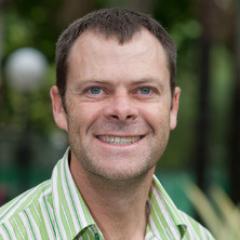A CBCS collaboration is connecting Baringa State Primary School students with the environment through “Frog Boxes” that feature the threatened wallum sedgefrog and other frog species. Queensland’s wallum wetlands lie alongside the newly created Sunshine Coast township of Aura, where the school is located, and are home to the wallum sedgefrog, which has been adopted as Aura’s emblem. The Frog Box is an innovative conservation tool that integrates acoustic data collected to inform habitat decisions on the Aura development into the Year 6 STEM curriculum. Use of the boxes in classrooms is fostering positive attitudes among students towards the environment and supporting them to develop their own environmental practices.
Bringing fieldwork to the classroom
The wallum wetlands are extremely sensitive to human disturbance, so Frog Boxes are a proxy for student fieldwork. Each Frog Box consists of a Raspberry Pi computer and display unit, a RFID reader and a rechargeable speaker. The outer casing is a simple rectangular shape provided to students to assemble from laser-cut flat pieces. The students built eight Frog Boxes over two one-hour workshops and later decorated them. Frog Boxes play an audio-visual snippet of a focal frog species calling, giving students 15 seconds to identify the species before revealing the scientific and common name overlaid on a still image. The videos play at random over 15-minute intervals, and each species’ video can be linked to an RFID card. The project also designed species information cards that familiarise students with each species’ morphology, scientific and common names and background information.
Given how recently Aura has been developed, few students have lived very long in the area. Frog Boxes are therefore playing an important role in engaging the students in a multi-pronged investigation of their local habitat to not only learn scientific concepts but also to develop a “sense of place” and a connection with nature by engaging with its sounds. Since their development for use in Baringa State Primary School, three Frog Boxes have also been distributed to families in the local Aura community for use at home, thus expanding their application beyond the classroom.
A CBCS-QUT collaboration
The Frog Box project is a collaboration between CBCS researchers Berndt Janse van Rensburg and Debra Stark and Queensland University of Technology researchers Margot Brereton, Kellie Vella, Alessandro Soro and Michael Esteban. It forms part of a larger collaboration with Stockland Development Ltd and the Sunshine Coast Regional Council under a successful Smart Cities and Suburbs Grant from the Australian Government. The grant provided for collaborations with teachers at the school to develop a “Frog Unit” comprising data processing workshops, educational talks and pond visits, with Frog Box one component of the unit’s activities.
Photo: Students assembling a Frog Box at Baringa State Primary School. Debra Stark.


